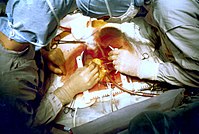
Photo from wikipedia
AIMS Some risk assessment tools have been developed to categorize mortality risk in heart transplant recipients, but it is unclear whether these tools can be used interchangeable in different transplant… Click to show full abstract
AIMS Some risk assessment tools have been developed to categorize mortality risk in heart transplant recipients, but it is unclear whether these tools can be used interchangeable in different transplant regions. METHODS AND RESULTS We performed a retrospective single-centre study in 1049 adult German heart transplant recipients under jurisdiction of Eurotransplant. Univariable and multivariable Cox regression analysis was used to generate a risk scoring system. C-statistics were used to compare our score with a US score and a French score regarding their ability to discriminate between 1 year survivors and non-survivors within our study cohort. Of 38 parameters assessed, seven recipient-specific parameters [age, height, dilated cardiomyopathy (DCM), ischaemic cardiomyopathy (ICM), total bilirubin, extracorporeal membrane oxygenation (ECMO), and biventricular assist device/total artificial heart (BVAD/TAH) implant], one donor-specific parameter (cold ischaemic time), and one recipient-independent and donor-independent other parameter (late transplant era) were statistically significant in predicting 1 year mortality. The initial score was generated by using the regression coefficients from the multivariable analysis as follows: 1.70 * ln age - 4.0 * ln height - 0.9 * diagnosis (= 1 if diagnosis = DCM) - 0.67 * diagnosis (= 1 if diagnosis = ICM) + 0.33 * ln total bilirubin + 1.74 * ln cold ischaemic time + 0.98 * mechanical circulatory support (MCS) implant (= 1 if MCS implant = ECMO) + 0.47 * MCS implant (= 1 of MCS implant = BVAD/TAH) - 0.66 * transplant era (= 1 if transplant era = 2017-2018). The initial score was converted into the Bad Oeynhausen (BO) score as a positive integer variable by means of the following formula: BO score = (initial score + 8) * 3. In patients scoring 2 to <7 points (n = 112), 7 to <11 points (n = 580), 11 to <15 points (n = 339), and 15 to 20 points (n = 18), 1 year survival was 93.1%, 84.2%, 66.9%, and 27.8%, respectively. The c-index of our score was 0.73 [95% confidence interval (CI): 0.69-0.77]. Values were in our cohort for the US and French scores 0.66 (95% CI: 0.62-0.70) and 0.63 (95% CI: 0.59-0.67), respectively. CONCLUSIONS Data indicate that our score, but also risk assessment tools from other transplant regions, may be used as a reliable support for risk-adjusted organ allocation and potentially help to improve outcomes in heart transplantation. Further developments will have to include as yet unaccounted risk factors for even more reliable predictions.
Journal Title: ESC heart failure
Year Published: 2021
Link to full text (if available)
Share on Social Media: Sign Up to like & get
recommendations!